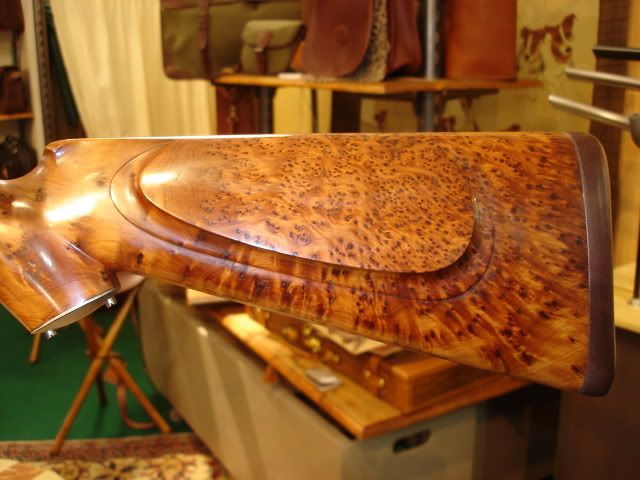The Accurate Reloading Forums
Name of this wood?
05 April 2006, 00:00
Stu CName of this wood?
I saw this at a show on the weekend. The maker told me the wood is from Morocco, is hard to find in gunstock sized pieces, and is called something like Thurl??? A quick search with that name came up with zip so I must have it wrong.
Anyone know any more about it?
- stu

05 April 2006, 00:12
Rusty MarlinIts called Thuya.
Absolutly geogeous. I made two pairs of grips for my Hawes .44's from it. I get compliments everywhere they are seen.
05 April 2006, 03:46
richjstu
beautiful stock. I never knew that you could get a blnk big enough;

05 April 2006, 06:34
333_OKHI deal in some of the exotic woods...typically not thuya burl as you have shown. It is a native of the western foothills of the Atlas Mountain, Atlantic Coast, North Africa [Morocco].
Here is the real deal of why you do not see it in gunstocks; thuya burls actually only form on the roots of the tree, so you have to dig the roots and find them large enough to slab for blanks. The regular wood from the tree is very unspectacular.
Do you have more pictures of the stock, maybe the whole thing? I cannot stop looking at is. What type of gun is it on?05 April 2006, 13:23
Stu CThanks for the information. I just couldn't remember the name of the wood.
quote:
Originally posted by 333_OKH:
Do you have more pictures of the stock, maybe the whole thing? I cannot stop looking at is. What type of gun is it on?
The rifle was a Ruger #1. The maker,
Tony Gicquel and his wife were very nice and spent a lot of time talking to me about the work.
Sorry, I didn’t take any other photos of this rifle. I was interested in the wood.
- stu
I don't think Thuya is native to either Europe or North Africa (I've got a Thuya hedge in my back yard).
Thuya Orientalis also known as Chinese Arborvitae or Oriental Arborvitae
Thuya Occidentalis also known as Eastern or American Arborvitae
Thuya Plicata also known as Western Red Cedar
I have no idea from which of these comes the wood used frequently in knife handles in France.
_________________________________
AR, where the hopeless, hysterical hypochondriacs of history become the nattering nabobs of negativisim.
05 April 2006, 23:05
333_OKHquote:
I don't think Thuya is native to either Europe or North Africa (I've got a Thuya hedge in my back yard).
Wink--
You actually answered your comment in your response. The italics say it all. The thuya you are discussing is the scientific name of the plant commonly known as "Bookleaf Cypress." The thuya in the case of the stock is not the scientific name but the common name, and it is from North Africa, specifically more common in Morocco. Scientifically, we are looking at
Tetraclinis articulata in the above photo.
Straight forward....right? LOL
Neat wood, but the stockmaker should've practiced more on some less exotic wood before he cut it.
Terry
--------------------------------------------
Well, other than that Mrs. Lincoln, how was the play?
333_OKH, thanks for providing the scientific name. It turns out that the French sometimes call this the Thuya de Berberie, or Barbary Thuya for a direct English translation. I looked it up of course and it seems that in addition to Morocco, it is found on the island of Malta and in one spot in the south of Spain. Thanks for clarifying this for me.
_________________________________
AR, where the hopeless, hysterical hypochondriacs of history become the nattering nabobs of negativisim.
06 April 2006, 19:36
ScrollcutterThanks for the info. I built a couple of one piece grips for a customer on Colt SAA's with wood that he supplied.
I thought he said that it was Thuya, but he picked it up on a trip to New Zealand. That wood was quite a bit redder and very soft and crumbly.
Roger Kehr
Kehr Engraving Company
(360)456-0831
08 April 2006, 22:50
333_OKHScrollcutter, it was probably not thuya, but rather amboyna burl (
Pterocarpus indicus).

I think it mainly comes from Myanmar and Cambodia in Southest Asia. Sometime people slip in a few other species that are similar, but not really the same, but lump them under the amboyna label.
Sometimes this wood can be chippy, and brittle when cut thin due to the intense burl grain pattern. It is best if you have this wood stabilized with acrylic from someone like Wood Stabilizing Specialists, International before using it on a knife, or pistol handles.
http://www.stabilizedwood.com/

